Suchergebnisse
BIGMODERN - Subprojekt 10: Evaluierung, Dokumentation und Sicherstellung der Übertragbarkeit
Das Subprojekt 10 ist Teil des Leitprojektes BIGMODERN. Es basiert inhaltlich auf dem Subprojekt Monitoring-Konzept und zielt darauf ab, die darin konzeptiv entwickelten Monitoring- und Evaluierungsschritte operativ während der ersten beiden Jahre des Gebäudebetriebes in den Demonstrationsprojekten umzusetzen.
EOR - EASEY Online Rating - a roadmap of a free of charge online service for small businesses
Preparation tool for the bank rating; model and indicators - concept for communication and technological options.
Thermoelektrischer Generator zur Ökostromerzeugung bei biomassegefeuerten Energieanlagen
Bei Biomasseheizwerken und Biomasse-KWK-Anlagen fällt Wärme zunächst bei hohen Temperaturen an, wird aber nur in einem Fernwärmenetz auf niedrigem Temperaturniveau verwertet. Unter Nutzung des thermoelektrischen Effektes kann aus dieser Temperaturdifferenz zusätzlich Strom generiert werden.
Technologietransfer zur Markteinführung multifunktionaler photovoltaischer Solarfassaden
Technologie- und Know-how-Transfer zur Markteinführung multifunktionaler photovoltaischer Solarfassaden. Konstruktive Umsetzung, Integration in das Gebäudeenergiesystem, Wirtschaftlichkeit. Gestaltung einer Website und Kommunikation mit ArchitektInnen, BauträgerInnen, PlanerInnen und Ausführenden.
ECR Energy City Graz - Subprojekt 3: Demobauvorhaben +ERS Plusenergieverbund Reininghaus Süd
Ziel des Projektes war es, ein Demonstrationsprojekt zu schaffen, das wirtschaftlich umsetzbare, technisch und organisatorisch innovative Lösungen für Plusenergieverbundkonzepte der Zukunft schafft. Der Plusenergieansatz für die Wohnsiedlung basiert auf Synergien innerhalb eines multifunktionalen Gebäudeverbandes.
IEA Bioenergy Task 40/Task 36: Transboundary flows of woody biomass waste streams in Europe (2019)

Der Bericht „Grenzüberschreitende Ströme von Holzbiomasseabfällen in Europa“ wird auf drei Seiten zusammengefasst.
Herausgeber: IEA Bioenergy Task 40
Englisch, 3 Seiten
Downloads zur Publikation
Revolutionary, cost efficient bitumen rooftop membrane with integrated photovoltaic modules
The project goal is to adapt the photovoltaic (PV) modules of crystalsol and an appropriately designed production process in order to integrate the flexible photoactive layer cost-effectively into waterproof roof membranes. At the end of the project the first membranes with integrated PV-layers will be produced. The success of this project would lead to enormous cost cutting and technological development advantages in the BIPV technology.
8. Symposium Energieinnivation Erfolgreiche Energieinnovationsprozesse
4. Feb 2004 - 6. Feb 2004
Technische Universität Graz Graz, AT
Energieinnovation ist eine sehr vielschichtige Thematik und erfordert eine systemische sowie interdisziplinäre Betrachtung der komplexen Fragestellungen. Wesentlich für den Erfolg von Energieinnovationen ist eine gründliche Analyse von Hemmnissen und Barrieren aus den verschiedenen Fachdisziplinen.
International Symposium on Anaerobic Digestion of Solid Waste and Energy Crops
28. Aug 2011 - 1. Sep 2011
Wien, AT
This conference will be a further bridge between basic research and full-scale application of anaerobic digestion.
Eröffnungsfeier der Biomethanaufbereitungsanlage Bruck an der Leitha
11. September 2015
Bruck an der Leitha
Am 11. September wurde die Eröffnung der Biomethanaufbereitungsanlage gefeiert. Diese bereitet seit einem Jahr bis zu 1.000 m³/h Biogas zu Biomethan auf und speist es als vollwertigen Erdgas-Ersatz ins Erdgasnetz ein. Die Demonstrationsanlage deckt die gesamte Wertschöpfungskette ab und stellt Biogas für alle Sektoren zur Verfügung: für Haushalte zur Wärmeversorgung, für die Industrie zur Wärme-, Kälte- und Stromerzeugung und für Tankstellen als Kraftstoff.
Smart Grids 2.0 Workshop: Österreich als Leitmarkt und Leitanbieter
27. Februar 2014, 10:00 - 17:30 Uhr
Kapsch Traffic Com, Europlaza Gebäude G1120 Wien, AT
Österreichs Komponentenhersteller und Systemlöser zeichnen sich im internationalen Wettbewerb durch die Bereitstellung integrativer Lösungen aus und haben das Potenzial auch für Smart Grid-Technologie-Lösungen Leitanbieter zu sein.
Dienstleistungsangebote des Baugewerbes zur Durchführung ökologischer Althaussanierungen

Umfassende Dienstleistungsangebote, welche u.a. Sanierungsberatung in Hinblick auf ökologische und energetische Aspekte, integrierte Planung und Ausführung der Sanierung, ökologische Bewertung und innovative Finanzierungsformen enthalten, werden gemeinsam mit Firmen entwickelt und in Pilotprojekten erprobt.
Thermisch-hygrisches Verhalten von GlasDoppelFassaden unter solarer Einwirkung
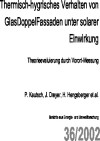
Schriftenreihe
36/2002
P.Kautsch, J. Dreyer, H. Hengsberger et.al.
Deutsch, 207 Seiten
Downloads zur Publikation
Möglichkeiten und Grenzen von Gebäudesanierungen auf Plusenergiehausstandard
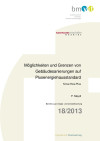
Know-How-Plus
Schriftenreihe
18/2013
P. Maydl
Herausgeber: BMVIT
Deutsch, 79 Seiten
Downloads zur Publikation
ÖKOinFORM Folder 5 - Fußboden im "Haus der Zukunft" Nachhaltigkeit durch NAWARO's
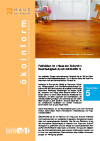
im Rahmen der Programmlinie Haus der Zukunft
J. Fechner, B. Lipp, R.Lechner
Herausgeber: BMVIT
Deutsch, 8 Seiten
Downloads zur Publikation
Development and application of an consultancy model to promote sustainable building design

Development of an consultancy model to promote ecologic and economic sustainable building solutions within the planning process. Analysis of the efficiency of guided (integral) meetings with architects, planners, and experts for different items.
Berichte aus Energie- und Umweltforschung 1a/2001Faser- und Färbepflanzen aus ökologischem Anbau - Erzeugung, Verarbeitung und Vermarktung

Erarbeitung von Grundlageninformationen und Strategien
Mehrsprachig
IEA (2007), Legal Aspects of CO2 Storage: Update and Recommendations, IEA/OECD, Paris.
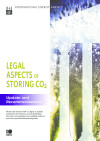
Diese Publikation behandelt die wichtigsten rechtlichen Themen im Umfeld der CCS-Debatte und zeigt Beispiele einer Rechtssprechung zur Ermöglichung von CCS.
International Energy Agency
Englisch, 144 Seiten
Downloads zur Publikation
Maßnahmen zur Minimierung von Rebound-Effekten bei der Sanierung von Wohngebäuden (MARESI)

MARESI entwickelt Strategien zur Minimierung von Reboundeffekten bei der energetischen Wohngebäudesanierung auf Basis von Mikrodatenanalysen und Fallstudien.
BIGMODERN Subprojekt 9: Demonstrationsgebäude Universität Innsbruck - Umsetzung
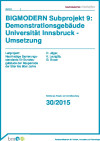
Leitprojekt: Nachhaltige Sanierungsstandards für Bundesgebäude der Bauperiode der 50er bis 80er Jahre
Schriftenreihe
30/2015
D. Jäger, K. Leutgöb, G. Bucar
Herausgeber: BMVIT
Deutsch, 48 Seiten
